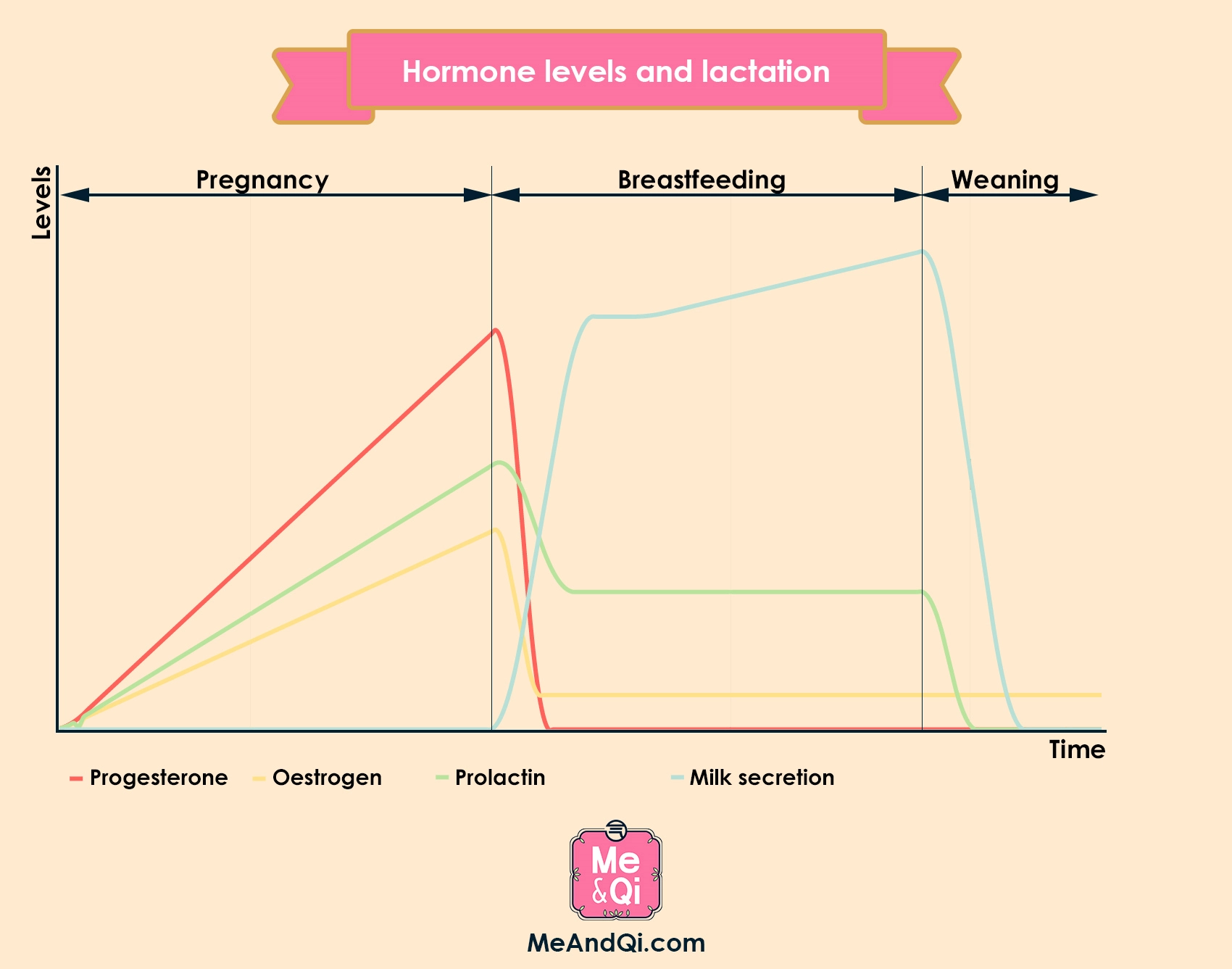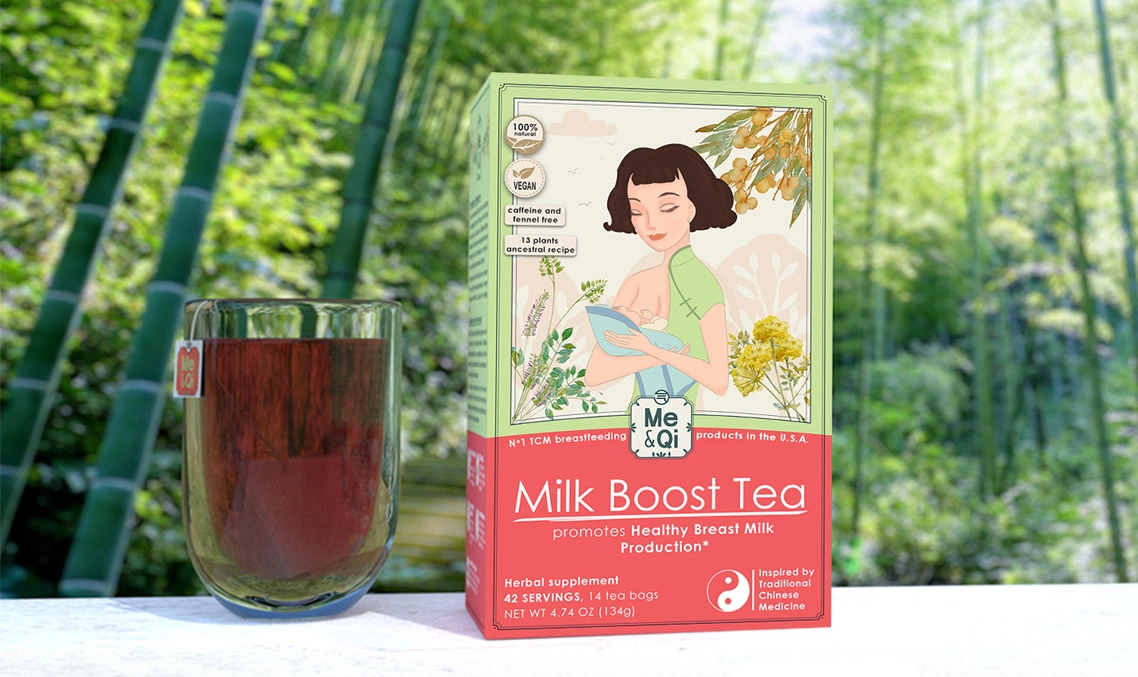There are many reasons why you'd want to induce lactation or force lactation. You might be an adoptive mother who wishes to breastfeed. You might have been separated from your baby after birth - often the case for premature babies. You might be into adult nursing relationship (ANR). The list goes on, the reasons are plenty.
Whatever your reason, this article will give you an easy recipe for successful induced lactation. Feel free to jump to the chapter that concerns you most or read through each one if you want a complete understanding of the topic:
- How does lactation work?
- Induce lactation in a nutshell (4 stages)
- Detailed steps to forcing lactation if:
- you have more than 90 days to prepare
- you have between 30 and 90 days to prepare
- you have less than 30 days to prepare
- Common questions about forcing lactation
- Procedure
- After I start pumping, how long does it take for milk to appear?
- Should I stimulate my breasts in a specific way during pumping sessions?
- Are there supplements I can take to help with milk production?
- What kind of pumping machine should I use?
- At what time of the day should I take Domperidone or Reglan?
- Should I have a specific diet that helps with lactation?
- Eligibility
- Can anyone induce lactation? Who is it designed for?
- Can I use this method to induce breast milk for adult breastfeeding (ANR) with my partner?
- I've had my reproductive organs removed, can I still induce lactation?
- Can I still produce breast milk if I am postmenopausal?
- Can transgender women induce lactation?
- Other
- Is my milk different when I induce lactation versus "natural" breastfeeding?
- How effective is the method to induce lactation?
- How much milk will I produce when I force lactation?
- Will inducing lactation affect my periods and fertility?
- Will inducing lactation affect my emotional state?
- Can I use inducing lactation as a weight loss method?
How does lactation work naturally?
Before we start explaining how to induce or force lactation, it's important to understand how nature lactation works in the first place.
There are basically three stages with three different drivers:
Stage 1: The hormones: right after giving birth, this is what triggers lactation
Stage 2: The constant removal of breast milk: once lactation is triggered, this is what drives the continued production of breast milk
Stage 3: The demand and supply equilibrium: once the milk production is stabilized, this is what drives the increase or decrease in milk supply volume
The hormonal system is the machinery that prepares the body for lactation and triggers it when the time comes. As you can see on the graph below, three main hormones are involved: progesterone, estrogen and prolactin.

Click on the image to make it bigger
During the course of pregnancy, progesterone and estrogen hormones are produced thanks to the presence of the placenta. Their levels constantly increase up to the stage of delivery when they drop dramatically due to the release of the placenta. Progesterone levels drop to almost zero and estrogen will remain low until the mother regains her periods.
These 2 hormones' main role is to prepare the breasts for lactation: bigger breast size, more alveoli, lactocytes, milk ducts, etc.
Prolactin levels also increase steadily during the course of pregnancy but, contrary to progesterone and estrogen, they're produced by the brain's pituitary gland. This means their production is not cancelled by the release of the placenta.
Prolactin is the key hormone that triggers lactation. High levels of progesterone and estrogen inhibit its expression but when those two hormones disappear at birth, prolactin can express itself and that's what effectively enables lactation to kick off. Between 16 and 22 weeks into pregnancy prolactin levels are theoretically high enough to trigger lactation but the constant release of progesterone and estrogen prohibits it.
Shortly after delivery, prolactin levels halve and remain constant until weaning. It can also decrease when solids are added to the baby's diet because that gives a signal to the body that weaning might come soon.
Inducing lactation in a nutshell (4 stages)
The basic principle of inducing or forcing lactation is to trick the body into thinking there was a pregnancy that came to term. It's the so-called Newman-Goldfarb protocols for inducing lactation. You do this by taking the three hormones described in the chapter above. In short, you mimic the hormones naturally released during pregnancy and birth giving.
This means that ideally you should have 6 months or more to prepare. The closer to the time period of a real pregnancy, the higher the chance of succeeding at expressing milk.
However if you prepare during less time, it doesn't necessarily mean you won't be successful at forcing lactation. Some women succeed within just a few weeks. A longer preparation time just increases your likelihood of success.
Now let's look at these 4 stages!
Stages 1: take pregnancy hormones
You need to take 3 hormones: progesterone, estrogen and prolactin. For the first two it couldn't be easier, you can simply take the birth control pill since it contains both. We're speaking here of the so-called "1-35" birth control pill with typically 1 mg of norethindrone (a progesterone medication) and 0.035 mg of ethinylestradiol (an estrogen medication).
To generate prolactin hormone, you need to take Domperidone (often sold under the brand name Motilium, among others). Domperidone is generally recognized as the most effective medication to stimulate prolactin. It's widely available worldwide but it's sadly not yet approved by the U.S. FDA so if you're based in the U.S. you should look at taking Reglan(a brand name for metoclopramide) which fulfills the same role, although slightly less effectively.
You need to keep taking this combination - birth control pill + Domperidone or Reglan - for at least 30 days non-stop. The longer this period (ideally 6 months), the better the result.
It goes without saying: please consult your doctor to check whether those medications are appropriate for your specific situation. All those medications are prescription only so it's a necessary step to discuss your plans with a doctor.
If you are over the age of 35 or are unable for some reason to use the estrogen-progesterone combination birth control pill, your doctor can replace it with either Provera 2.5 or Prometrium 100 mg. The birth control pill is not advised for women over the age of 35 because of health risks associated with its use, hence the replacement. Again, kindly discuss all this with your doctor to understand what most makes sense for you.
Stage 2: stop taking the birth control pill at once
In order to mimic birth giving and the release of the placenta, you need to stop taking the birth control pill suddenly. The pill contains both progesterone and estrogen, the hormones released by the placenta. The sudden drop will make your body believe that your placenta was released. To your body, this means birth has occurred and lactation can begin.
Progesterone and estrogen are also the hormones that inhibit the effect of prolactin, the lactation hormone you're getting from Reglan or Domperidone. By quitting them, you enable prolactin to kick off lactation.
Stage 3: start suckling or pumping and take galactagogues
As soon as you stop taking the birth control pill in step 2 it's critical you start suckling or pumping frequently.
Ideally you should do so at the same frequency as a newborn baby, i.e. every 2 to 3 hours. Stopping the birth control pill made your body think you just gave birth, now you need to make it think you have a newborn who needs regular feedings.
To help create your milk supply, you can drink galactagogue teas such as Milk Boost Tea. It's packed with 13 different natural plants that each play a role in supporting lactation. These plants have literally been used for millennia to help support women when they breastfeed.


For instance among its ingredients is Dong Quai, a root also known as the "female ginseng" for its wide range of health benefits for women. It also contains Sponge gourds (Loofah), famous for their ability to facilitate lactation. Yet another example is Longan, a fruit that has a great ability to nourish the Blood and relieve fatigue.
Stage 4: once lactation is establish, stop prolactin-inducing medication
Within maximum one to two weeks of regular pumping or suckling (approximately every 3 hours), you should start getting some breast milk. After that, you milk volume should steadily increase as you keep regularly pumping.
At one stage, when you see that you're getting just as much milk as any breastfeeding woman, feel free to stop taking Reglan or Domperidone. At this stage, the prolactin hormone doesn't matter as much anymore. Your milk volume is most driven by the demand and supply equilibrium.
Also by this stage, your body will anyhow be producing prolactin on its own so there is no need to supplement it.
Keep drinking Milk Boost Tea however as it helps you keep a steady production of breast milk and gives your body some of the fuel it needs to produce your milk.
You're done!
By this stage, you should hopefully be lactating like any breastfeeding mother!
As such you'll face similar problems such as engorgement and blocked ducts as well as supply issues. If you want more milk, read what you can do to increase your milk supply or, if you have too much milk, how you can decrease it safely.
Rarely, especially if you didn't spend enough time in step 1, you might struggle to get more than a small trickle of breast milk. This is sometimes due to your milk ducts not being large enough or being blocked somehow.

If that's your case you might want to give Unblock Nursing Tea a try. It's an herbal tea made of 12 natural herbs that's designed to help fight off engorged breasts and clogged ducts. It might be just what you need to unblock your milk ducts and transform that trickle into a nice flow!
Of course, while you drink it it's critical you continue pumping your breasts very regularly as that gives your body the signal to keep up your milk production.
You might want to read more detailed steps based on your personal situation. Here are the detailed steps to inducing lactation if:
- you have more than 90 days to prepare
- you have between 30 and 90 days to prepare
- you have less than 30 days to prepare
Common questions about forcing lactation
Questions about the procedure
After I start pumping, how long does it take for milk to appear?
Everyone responds differently. It may take a few days, a week or more for your milk to start appearing.
In general the longer your preparation time in step 1, the better the result.
Should I stimulate my breasts in a specific way during pumping sessions?
Yes! The recommended way to go about a pumping session is as follows:
- Pump for approximately 5 minutes on the low to medium setting
- Massage, stroke and shake your breasts (see below)
- Pump for another 5 minutes
To massage your breasts, move your fingertips in concentric circles while applying some pressure starting from your chest area and moving towards your nipples. This helps empty your alveoli (the grapes where the milk is stored) into your ducts and therefore drain your breasts.
To stroke your breasts, slide the fingernail side of your finger from the top of your breast towards your nipples. This also helps empty your alveoli into your ducts.
To shake your breasts, lean over and shake your body so as to move your breasts. This makes use of gravity to help once again empty your alveoli into your ducts.
Are there supplements I can take to help with milk production?
As per step 3, the main supplement we recommend is Milk Boost Tea.
We recommend you start drinking it once your lactation started. It can be compared to starting a car. At this stage, you've started off the engine, but you need a constant fuel supply for it to keep going. That's the role fulfilled by the 13 plants in Milk Boost Tea.


The best course is to drink 2 to 3 bags of it a day: you can re-use each bag 3 times so that makes 6 to 9 cups. Liquid intake in and of itself really helps milk supply. Remember, 87%-90% of breast milk is actually water.
What kind of pumping machine should I use?
You must have a double side electronic pumping machine. It is much more efficient.
At what time of the day should I take Domperidone or Reglan?
For better absorption by your body, take Domperidone or Reglan about 1/2 hour before meals.
Should I have a specific diet that helps with lactation?
Try to have a balanced diet with a good mix of fat (good fats only!), proteins and carbs because that's what breast milk is composed of.
Good fats, so called "long-chain polyunsaturated fatty acids", are especially important. That's because they're a key reason why breast-fed infants perform better on tests that assess neurodevelopmental outcomes than do formula-fed infants.
Questions about eligibility
Can anyone force lactation? Who is it designed for?
This method is mostly designed for the following scenarios:
- Relactation: when you've lactated in the past, stopped for a period of time and want to lactate again
- Adopted kids, surrogates: when you want to breastfeed a baby you weren't pregnant with
- Separation after birth: for instance, premature kids that you couldn't breastfeed for a while after birth
It can also be used for other scenarios. The protocols described here have been successful for postmenopausal women, women who suffer from ovary dysfunction/ablation or even transgender women.
Can I use this method to induce breast milk for adult breastfeeding (ANR) with my partner?
Yes of course, it can be used for this purpose.
The main difference will be on the suckling part once you've started lactating. At that stage the continued production of breast milk is driven by the constant removal of breast milk. If you want to keep lactating, when your partner is not suckling you'll therefore need to pump your milk out regularly.
I've had my reproductive organs removed, can I still induce lactation?
As soon as your breasts and your pituitary gland (that produces hormones) are functioning, you can induce lactation. Reproductive organs are not necessary to make milk.
Can I still produce breast milk if I am postmenopausal?
A woman who is postmenopausal can still produce milk. The only requirements are functioning breasts and pituitary gland.
The birth control pill that you would take in step 1 may even alleviate menopausal symptoms if there are any. Please note however that the estrogen-progesterone combination birth control pill is often unadvised for women over the age of 35 because of associated health risks. Your doctor can replace it with either Provera 2.5 or Prometrium 100 mg.
Can transgender women induce lactation?
Even though it is not common, there are several cases on record of transgender women succeeding at inducing lactation by using protocols similar to the one described here.
With a bit of determination and the right method, anyone with functioning breasts can achieve breastfeeding.
Other questions
Is my milk different when I induce lactation versus "natural" breastfeeding?
Your milk will come into stages. At first your should see quite clear drops, which almost look like slightly opaque water. This is of course quite different from normal breast milk or the colostrum you get when you start breastfeeding right after giving birth.
As you keep pumping and expressing milk, it will become more and more opaque and white until, after a few days, it becomes proper breast milk. At that stage it is indistinguishable from any other breast milk.
Once the breast milk resulting from forced lactation is mature, its nutritional qualities are the same as a new mum's breast milk. The resulting breast milk is also just as smart in that, if you breastfeed a baby, it will adapt its composition to the needs of the baby's immune system.
Please be aware that a certain amount of Reglan (less than 10%) can be passed to the baby through breastfeeding if this is the prolactin stimulator the mother uses. In any case, once the breast milk is flowing normally, there is no need for you to keep taking Reglan.
How effective is your method to induce lactation?
The Newman-Goldfarb protocol, on which our steps are based, have a high success rate. Most women who follow this protocol can meet their baby’s breast milk needs and sustain until weaning.
It can even work on a population that wouldn't normally be able to breastfeed like postmenopausal women, women who suffer from ovary dysfunction/ablation or transgender women.
The longer the preparation time in step 1 - ideally 6 months - the higher the chance of success. Other success factors include:
- Whether you take hormones or not (birth control pill + Reglan or Domperidone). Obviously much more successful if you do but some women still succeed by starting directly at step 3.
- Having lactated in the past, especially if your previous lactation occured not long before.
- Your determination and motivation. It takes a lot of work, especially step 3 (the pumping and stimulating of the breasts).
- A support network around you. This is very important to keep you motivated.
- Use of galactagogues, such as Milk Boost Tea.
- A good double-sided electronic pumping machine.
- The mother's daily activities and emotions. Stress and anger for instance have a negative impact on your lactation.
- The breasts' condition.
How much milk will I produce when I force or induce lactation?
It really depends. If your purpose is relactation, meaning you've already breastfed the same baby you wish to relactate for, you will likely manage to produce just as much as any breastfeeding woman.
A study on 50 women who tried relactation using a method similar as the one described above found that 92% of the women achieved exclusive breastfeeding, 6% partial breastfeeding and only 2% didn't achieve any lactation at all.1
In other cases only a small minority of women who induce lactation for a baby they didn't previously breastfeed manage to express enough milk to cover all of the baby's nutritional needs. The typical range is between 25% and 75%.
Will inducing lactation affect my periods and fertility?
Yes, the hormones you take in step 1 will make your periods stop and, this being the birth control pill, will make you infertile for the time period during which you take it.
Once you've starting lactating and stopped taking the hormones, the rules are the same for you as any other breastfeeding woman.
Will inducing lactation affect my emotional state?
It is a very likely side effect as we're dealing with hormones, which have a large impact on emotions.
Often, the hormones you take in step 1 or naturally generated by your body once you've started lactating will give your mood a boost and help decrease your stress levels.
Sometimes, though, the contrary may occur: they might make you tired, stressed, depressed or overwhelmed.
Can I use inducing lactation as a weight loss method?
Lactation is a primary driver for a mother's weight loss postpartum. It makes sense, it takes a lot of calories to produce milk and you give out a lot of your calories in your breast milk.
As a general rule, a lactating woman loses about 500-700 additional calories compared to non-lactating woman.
This means that, assuming your food intake doesn't increase correspondingly, you can lose weight from lactating.
All this being said, that obviously shouldn't be your primary driver for doing this, it's just a nice bonus on the side!
Sources:
1. Seema, MD, A. K. Patwari, MD, DCH, MNAMS, L. Satyanarayana, MSc, Relactation: An Effective Intervention to Promote Exclusive Breastfeeding, Journal of Tropical Pediatrics, Volume 43, Issue 4, August 1997, Pages 213–216, https://doi.org/10.1093/tropej/43.4.213

